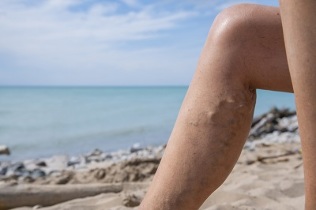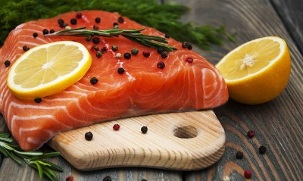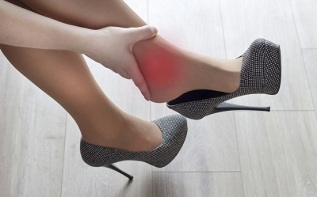
One of the problems of many women and about 15% of men is varicose veins in the legs. In this disease, the ducts in the legs (veins), which return blood rich in carbon dioxide and residual metabolic products, become deformed, dilate, lose tone and appear under the skin.
In addition to cosmetic defects, changes in the structure of the veins and circulatory disorders cause unpleasant sensations in the legs as well as pain, edema, and heaviness. Although there are various medical tools and procedures that help in the treatment, it is important from the beginning, as soon as the first signs of varicose veins appear, to do prevention - this will help prevent pain, swelling, tired feet, external cosmetic defects.
What's the problem?
Varicose veins, commonly referred to as varicose veins, are severe changes in the walls of the veins, their weakness, excessive stretching, as dark blue or purple swollen veins appear under the skin. In the early stages, small "stars" from the widening capillaries, small bouquets, and later larger ones may appear.
The veins have a special structure: in addition to the elastic wall, they also have a small valve (pocket) that prevents blood from flowing in the opposite direction. Varicose veins form when the valves on the vein wall weaken, stretch, deform, and do not close completely. Excessive wall stretching and valve defects eventually lead to the fact that blood flows worse through the ducts, its movement slows down and even stops. First, small veins appear in the form of "stars" or spider legs, and then thicker and thicker convoluted veins appear.Other symptoms of varicose veins may arise such as:
- burning in calves, throbbing sensation;
- discomfort in the legs, heaviness or pain;
- Muscle cramps, cramps, more pronounced at night;
- swelling of the feet and ankles;
- dry or itchy, pale skin that looks thinner than healthy skin
If there is a tendency for varicose veins or the first symptoms to appear, there are a number of procedures that eliminate discomfort and pain in the legs, helping to improve blood circulation and vein tone.
Exercise and physical activity

Exercising regularly increases blood circulation in the legs. Muscle contraction helps push the blood that has accumulated in the veins. Exercise also helps lower blood pressure, which is another negative factor contributing to varicose veins.
Low intensity exercise helps with calf muscle contraction. They work without unnecessary stress.
Effective and low-impact training includes:
- swim;
- running;
- cycling;
- yoga.
Stockings and compression stockings
Compression stockings are available at most pharmacies and orthopedic stores. They distribute the pressure to the legs, squeezing the vein walls from the outside. It helps move blood to the heart and relieves blood congestion in the lower legs. The study found that people who wear compression stockings along the knee maintain a pressure between 18 and 21 mmHg. within one week, there was a reduction in the pain and discomfort associated with varicose veins. It is important to choose socks and tights with a doctor or salon specialist so as not to be mistaken with the level of compression.
Plant extract
Studies show that horse chestnut extract can help relieve leg pain, heaviness and itching on the skin in people with chronic venous insufficiency (one of the leading causes of varicose veins).
Survey studies report that sea pine extract and meat rub extract can reduce leg swelling or edema, which is often associated with varicose veins.
Plant extracts and essential oils should be diluted before use on the skin or used in aromatherapy spreaders.
Diet changes

Salted or sodium-rich foods contribute to swelling, including in the legs and ankles, so reducing salty foods can minimize water retention. Foods high in potassium such as almonds and pistachios help in the prevention and treatment of varicose veins by reducing water retention in the body. This group includes:
- almonds and pistachios;
- lentils and white beans;
- potatoes;
- leafy vegetables;
- some types of fish, such as salmon and tuna.
Fiber foods help maintain bowel function and prevent constipation. This can be important, as pressure can damage the valve or cause blood clots in the veins. High fiber foods include:
- nuts, seeds, and beans;
- wheat, wheat and flax seeds;
- whole grains.
Flavonoids in food
Adding foods containing flavonoids to the diet also helps reduce the risk of varicose veins. Flavonoids, as a biologically active substance, improve blood circulation, maintain uniform blood flow and reduce the likelihood of blood accumulation in veins. They also help lower blood pressure in arteries and loosen blood vessels, reduce pressure on veins and reduce the risk of varicose veins.
Foods containing flavonoids include:
- vegetables: green onions, peppers, spinach and broccoli;
- citrus and grapes, cherries, apples and blueberries;
- koko;
- garlic.
Herbal medicine
Some herbal preparations help calm the veins and reduce their deformation. It is believed that the intake of grape seed extract can reduce leg swelling and other symptoms of chronic venous insufficiency, although at present there is little evidence of its effectiveness. If you are taking blood thinners, you should avoid taking grape seed extract as a supplement, as it may interact with the medication and increase the risk of bleeding.
Choosing the right outfit

Wearing tight, tight and synthetic clothing can restrict blood flow to your feet. Wearing loose, breathable clothing that does not restrict blood supply to the lower body increases blood flow through the veins and reduces valve deformation.
It is also forbidden to wear tight, tight shoes. Shoes with narrow toes put pressure on blood vessels and cause pain. It is best to choose shoes with orthopedic soles.
Wearing shoes with low heels or with comfortable and stable soles instead of high heels can also relieve the pain of varicose veins on the feet.
Need to lift legs more often
Raising the legs up regularly, corresponding to the same height as the heart, or higher, helps improve blood circulation. This reduces the pressure on the leg veins, and gravity helps the blood flow back to the heart smoothly. You should try to lift your legs if you intend to sit for long periods of time, such as while working or resting.
Sort
Massage the feet, legs, and thighs lightly to keep blood in your veins. You can use a gentle massage oil or moisturizer for optimal results. However, it is very important to avoid direct pressure on the veins, as this can damage the fragile tissue. No less useful is a massage with a shower in the bathroom, including contrast.
Continuous movement
Avoid sitting for long periods of time. If you have to sit at work for a long time, you should try to get up and move, or at least change positions frequently until the blood flows completely through the veins of the legs.
Avoid sitting cross-legged as this can restrict blood flow to the legs and feet and worsen circulatory problems.
Treatment procedures for varicose veins

If preventive measures at home do not improve your vein condition, severe discomfort, pain and swelling occur, medical treatment is needed to get rid of varicose veins.
The doctor may prescribe the following:- Endothermic neglect.This is a procedure in which heat is used to close the affected vein;
- Ambulatory phlebectomyThe doctor pierces the skin and removes the varicose veins through a small incision. This procedure is performed under local anesthesia, with almost no scars left;
- Sclerotherapy.This procedure uses special foam to cover damaged veins. Blood will flow through the short vein system;
- Ligation and removal.In this procedure, varicose veins are removed surgically;
- Laser operation.A strong spray of light is directed at the vein, causing it to fade;
- Endoscopy surgery.During this operation, a small video camera is inserted into the foot to help the surgeon see better what is happening to the vein. The vein is removed through several small incisions.
Future Forecast
Varicose veins cause cosmetic discomfort and defects. Prevention of varicose veins at home is possible, and diet and lifestyle changes can reduce unpleasant symptoms. But as the disease progresses, you need to seek medical help to remove the visible defects and heal the veins themselves.




































